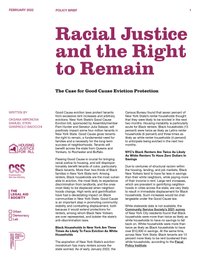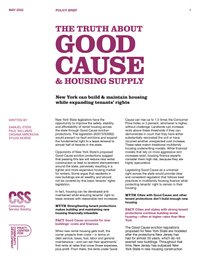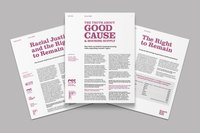
Pratt Center, the Community Service Society of New York and other housing advocacy groups are supporting the efforts of the Housing Justice For All coalition through a series of policy briefs which make the case for Good Cause Eviction Legislation in New York State.
Background
An estimated 591,000 households in New York State were behind on rent as the state’s pandemic eviction moratorium expired on January 15, 2022. With pre-COVID eviction rates already high (nearly 100 families evicted daily in New York State), and rents rising rapidly throughout 2021, renters are in trouble. The National Equity Atlas estimates that 79% of those behind on rent in New York are low income and 72% are people of color.
Housing advocates are calling on New York State legislators to give renters greater security, stability and legal protection in the form of statewide Good Cause Eviction legislation. The bill (A5573/S1603) introduced by State Senator Julia Salazar and Assemblymember Pamela Hunter, would prevent no-fault evictions and expand the fundamental right to a lease renewal to almost half of tenants in the state.
Part 1: The Right to Remain
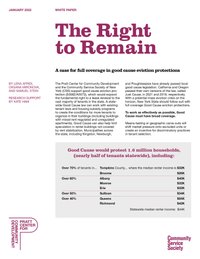
Downloads
In The Right to Remain: A Case for Full Coverage in Good Cause Eviction Protections, Pratt Center and the Community Service Society of New York make the case that in order for Good Cause legislation to be as effective as possible it must be applied broadly, without means testing or geographic carve outs.
The analysis finds:
Good Cause would protect 1.6M households, nearly 50 percent of tenants statewide, the majority of whom live in counties with a median income at or lower than the state median income of $68,486.
The vast majority of unregulated tenants in the state live in units that rent under $3K a month. About 5 percent (172,000 units), however, rent for more than $3,000. A significant proportion of tenants in high-cost rentals are part of multi-generational households, in which multiple workers often share responsibility for covering the rent.
Many households in high-cost rentals are immigrant families. Forty percent of high-cost renter households in Queens speak a language other than English at home, as do more than 34 percent in Nassau, 36 percent in Suffolk, 25 percent in Manhattan, and 21 percent in Brooklyn.
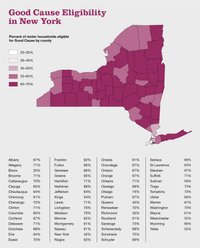
Part 2: Racial Justice and the Right to Remain
The second report in the series, Racial Justice and the Right to Remain, details how Black New Yorkers continue to face inequities when securing and maintaining permanent housing.
Findings from the report include:
Black tenants in NYC are twice as likely as white tenants to have zero dollars in savings.
Black households in New York are three times as likely to face eviction as white households.
Across New York, evictions filed at higher rates in counties with high shares of Black renters.
The report also offers solutions to these racial disparities by calling on the New York legislature to pass Good Cause Eviction.
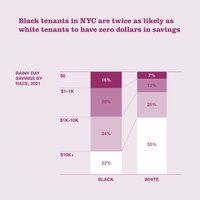
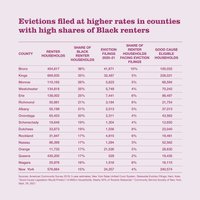
Part 3: The Truth about Good Cause & Housing Supply
The third report, co-published by Pratt Center and the Community Service Society of New York, examines arguments that the proposed Good Cause legislation would reduce investment in housing and hamper the state’s housing supply, and finds that in states and cities that have passed similar tenant protections, the pace of building has not slowed and housing quality was not affected.
The report shows that:
New Jersey, which passed a Good Cause law in 1974, has outpaced New York State in new housing construction over the nearly 50 years, a trend that’s only accelerated in the last 12 years.
Jersey City, which has strong rent control regulations in addition to the State’s Good Cause law, has some of the fastest rates of housing production in the country. Good Cause has not shifted this development towards condominiums from rental housing; the proportion of rental and homeowner housing built is essentially the same today as 50 years ago.
Rents in newly constructed buildings across the state are not targeted only to higher-than-average incomes, and exempting new construction would hurt tenants at a range of incomes across the state. In three of New York’s biggest cities, Buffalo, Syracuse and Albany, the income needed to afford the median rent in new buildings was lower than the median household income for the cities as a whole.
Reasonable rent increases as defined in New York’s Good Cause bill, 3% per year or 1.5x the Consumer Price Index, align with best practice in multifamily housing lending; these tenant protections would not make housing development financially infeasible, as opponents argue.
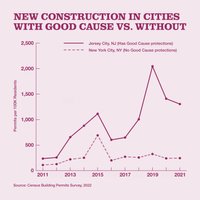
The report also looks at cities around the globe with Good Cause-type laws like Tokyo, Montreal, and Zurich, finding that high rates of new housing construction have continued even after the laws were passed. In addition to new construction, the report examines arguments that Good Cause would lead to landlord disinvestment. The report shows that rent control in New Jersey municipalities hasn’t impacted housing quality, and that, in cities including Washington, D.C., expanding legal protections around lease renewal makes tenants more likely to assert their right to request repairs.
